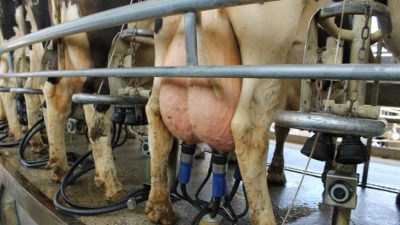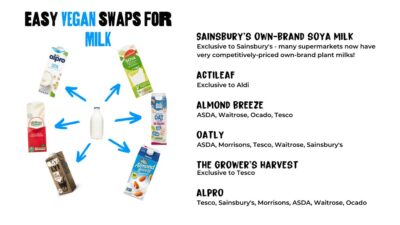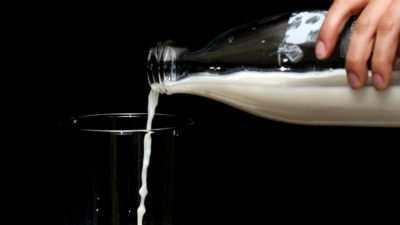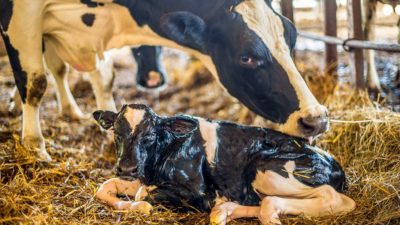How Beef Cattle Are Farmed and Killed

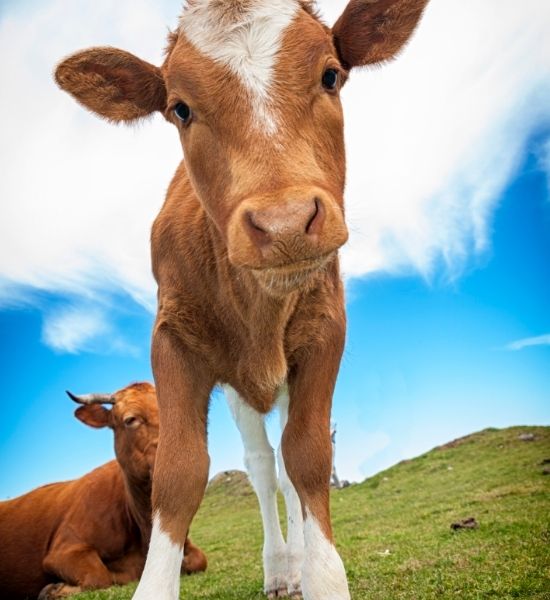
Fun facts about cows
- Cows recognise different people and will pretend that they haven’t been fed in order to get second helpings!3Barkham P. 2017. Cows are loving, intelligent and kind – so should we still eat them? The Guardian, 30 October. Available at https://www.theguardian.com/environment/2017/oct/30/secret-life-of-cows-loving-intelligent-kind-eat-them [Accessed 25 March 2020].
- Cows have been known to play hide-and-seek, although they’re rather too big to be very good at the game1Barkham P. 2017. Cows are loving, intelligent and kind – so should we still eat them? The Guardian, 30 October. Available at https://www.theguardian.com/environment/2017/oct/30/secret-life-of-cows-loving-intelligent-kind-eat-them [Accessed 25 March 2020].
- Cows like to problem-solve and may get excited when they find solutions1Barkham P. 2017. Cows are loving, intelligent and kind – so should we still eat them? The Guardian, 30 October. Available at https://www.theguardian.com/environment/2017/oct/30/secret-life-of-cows-loving-intelligent-kind-eat-them [Accessed 25 March 2020].
- Cows are emotionally complex, have strong family bonds and grieve for calves they lose1Barkham P. 2017. Cows are loving, intelligent and kind – so should we still eat them? The Guardian, 30 October. Available at https://www.theguardian.com/environment/2017/oct/30/secret-life-of-cows-loving-intelligent-kind-eat-them [Accessed 25 March 2020].
- Cows make different noises to address different cows in the herd, just like people use different names for different individuals4Press Association. 2014. Cows communicate using individual sounds like human names’. The Telegraph, 16 December. Available at https://www.telegraph.co.uk/news/newstopics/howaboutthat/11297269/Cows-communicate-using-individual-sounds-like-human-names.html [Accessed 25 March 2020].
- Cows can self-medicate, choosing to eat certain plants when they’re unwell; similar to people eating more fruit or hot soup when feeling sick!1Barkham P. 2017. Cows are loving, intelligent and kind – so should we still eat them? The Guardian, 30 October. Available at https://www.theguardian.com/environment/2017/oct/30/secret-life-of-cows-loving-intelligent-kind-eat-them [Accessed 25 March 2020].
The Maternal Instinct of Cows
Cows are highly social animals with a strict hierarchy. Within herds, the social structure is based on matriarchal families; mother cows and their daughters remain grooming and grazing partners for life and typically have very strong bonds with each other.1 Sowell BF, Mosley JC and Bowman JGP. 1991. Social behavior of grazing beef cattle: implications for management. The American Society of Animal Science. 77, 1-6. Cows also form lifelong friendships with other cows to form a herd and calves befriend other calves for the rest of their lives.2 Young R. 2003. The Secret Lives of Cows. Faber & Faber: London.Herds like stability; any disruption to the group, such as the addition of a new member, can be very stressful.1 Sowell BF, Mosley JC and Bowman JGP. 1991. Social behavior of grazing beef cattle: implications for management. The American Society of Animal Science. 77, 1-6.
 Just like humans, cows are extremely protective and caring of their offspring. They give birth in private and hide the calf in long grass out of sight for about a week before introducing the newborn to the rest of the herd.1 Sowell BF, Mosley JC and Bowman JGP. 1991. Social behavior of grazing beef cattle: implications for management. The American Society of Animal Science. 77, 1-6. The herd approves the new member who then joins them. Female calves suckle from their mother for nine months and then stay together for the rest of their lives. Male calves suckle for about a year and then leave to join a bachelor herd.
Just like humans, cows are extremely protective and caring of their offspring. They give birth in private and hide the calf in long grass out of sight for about a week before introducing the newborn to the rest of the herd.1 Sowell BF, Mosley JC and Bowman JGP. 1991. Social behavior of grazing beef cattle: implications for management. The American Society of Animal Science. 77, 1-6. The herd approves the new member who then joins them. Female calves suckle from their mother for nine months and then stay together for the rest of their lives. Male calves suckle for about a year and then leave to join a bachelor herd.
While cows are sometimes portrayed as lacking intelligence, studies have shown that cows enjoy problem-solving, recognise individual humans, play games and have a variety of vocal calls to communicate with one another 3Kettlewell J. 2005. Farm animals need emotional TLC. The BBC, 18 March. Available at http://news.bbc.co.uk/1/hi/sci/tech/4360947.stm [Accessed 25 March 2020].4Press Association, 2014. Cows communicate using individual sounds like human names. The Telegraph, 16 December. Available at https://www.telegraph.co.uk/news/newstopics/howaboutthat/11297269/Cows-communicate-using-individual-sounds-like-human-names.html [Accessed 25 March 2020].5Barkham P. 2017. Cows are loving, intelligent and kind – so should we still eat them?. The Guardian, 30 October. Available at https://www.theguardian.com/environment/2017/oct/30/secret-life-of-cows-loving-intelligent-kind-eat-them [Accessed 25 March 2020]. Cows have different personalities, hold grudges with one another, bicker, bond and form friendships that can last a literal lifetime.6University of Groningen. 2012. Dairy cows have individual temperaments. ScienceDaily, 23 March. Available at https://www.sciencedaily.com/releases/2012/03/120323134531.htm [Accessed 25 March 2020].
Cattle can also feel depression and anxiety. For example, calves kept in isolation hutches – a standard practice in the dairy industry – show clear signs of depression, just like solitary confinement affects humans negatively.7Gaillard C, Meagher RK, von Keyserlingk MAG et al. 2014. Social housing improves dairy calves’ performance in two cognitive tests. Public Library of Science One, February 26. Available at https://doi.org/10.1371/journal.pone.0090205 [Accessed 25 March 2020]. There are clear similarities between cows and other animals, such as dogs or even ourselves, as highly social animals who depend upon one another for mental wellbeing.
Unfortunately, despite the emotional complexity and intelligence evident in dairy cows, the way they are treated in modern UK farming shows a complete disregard for their wellbeing and their sentience.

Cattle are highly intelligent, sentient mammals who have evolved complex social behaviour over thousands of years. Their natural lives are very different to those they are forced to lead on farms.
Where do cows descend from?
Cattle are members of the Bovidae family, which includes antelope, goats, sheep, bison and buffalo. Modern domestic cattle (Bos taurus) descend from the much larger, now extinct aurochs (Bos taurus primigenius) which once ranged throughout Britain, Africa, the Middle East, India and central Asia. Cows have been domesticated since 6500 BC, and selective breeding over the millennia has caused dramatic physical changes – so drastic that domesticated cattle are now considered a separate species.
Semi-wild cattle
Populations of semi-wild cattle still survive in several countries, including the white cattle of Chillingham Park in Northumberland, who have roamed free for at least 800 years. Studies of this herd and other semi-wild herds have provided insight into natural cattle behaviour.
Semi-wild cattle form small groups, averaging 15-20 animals with a strict social hierarchy. The structure is matriarchal and offspring inherit the mother’s status in the herd. It is common for calves to establish lifelong friendships at a young age and mutual grooming reinforces social bonds between cows.
Natural diet
Contrary to the popular belief that cows just eat grass, they like a mixed diet. Just as humans have preferences for different foods, depending on the time of day, cattle show a preference for clover in the morning and grass in the evening, with more of an inclination towards clover than grass in general 1Rutter SM, Orr RJ, Yarrow NH et al. 2004. Dietary preference of dairy cows grazing ryegrass and white clover. Journal of Dairy Science. 87 (5) 1,317-1,324. Available at https://www.sciencedirect.com/science/article/pii/S0022030204732816 [Accessed 25 March 2020].
Life expectancy of cattle
Cattle have a life expectancy of approximately 20 years; some, at sanctuaries, have even been known to live into their 30s.
Predators
Depending on the location, cougars, lions, wolves and bears have been known to hunt cattle.
Semi-wild cattle and modern cattle
Much of the behaviour found in semi-wild cattle can still be found in domesticated cattle. Despite having strong maternal instincts and a clear desire to bond with a stable herd, in modern dairy farming calves are removed from their mothers shortly after birth. Cows have been known to grieve and fall into deep depression as a result, much like the loss a human mother would feel if her baby was forcibly removed 2University of Veterinary Medicine. 2015. Early separation of cow and calf has long-term effects on social behavior. ScienceDaily, 28 April. Available at https://www.sciencedaily.com/releases/2015/04/150428081801.htm [Accessed 25 March 2020].. Cows’ strict social hierarchies cannot be maintained in the dairy industry, where herds vary significantly in size and there are frequent additions and removals.
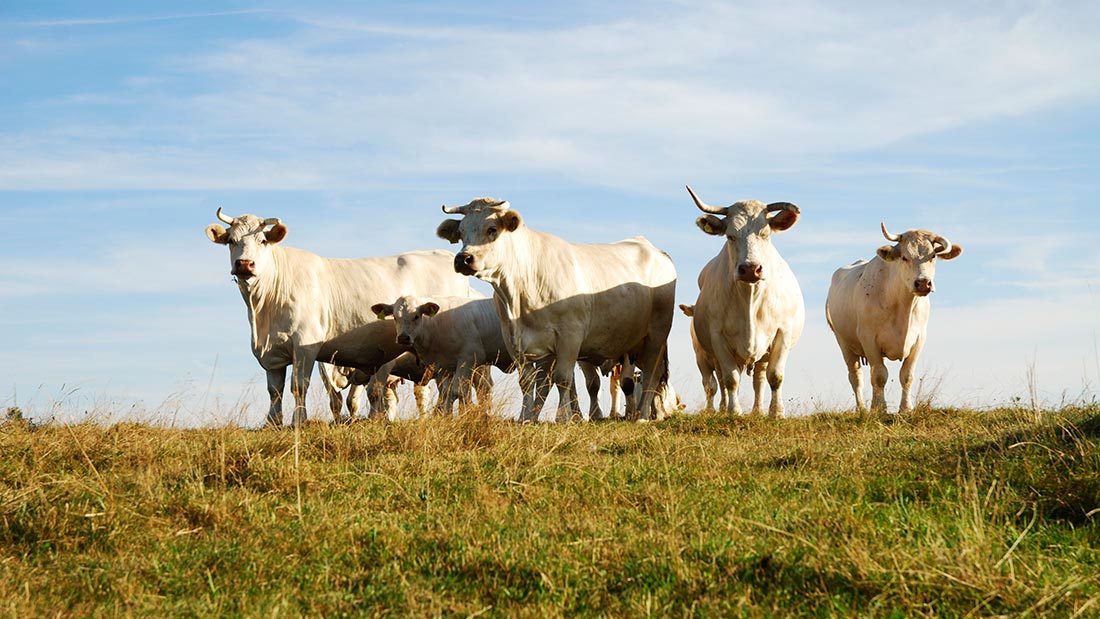
While it’s common to think of beef coming from happy cows in green pastures, the reality is very different, with cattle experiencing acute suffering. Even in the best systems, calves suffer routine mutilations, separation from their mothers and the terrifying journey to the slaughterhouse. All beef cattle have their lives cut very short – killed at just one to two years old, the equivalent of a human life ending at just four to eight years old.
The size of the beef industry
There are around four million beef cattle in the UK at any given time.1Agricultural and Horticultural Development Board. 2019. The UK cattle yearbook 2019. AHDB. Available at https://ahdb.org.uk/knowledge-library/the-uk-cattle-yearbook-2019 [Accessed 9 April 2020]. Over two million ‘prime cattle’ (cattle raised solely for beef production) were slaughtered in 2022, along with 126,000 calves and 656,000 cows (and adult bulls) from the dairy industry, which is a typical yearly total.2Agriculture in the UK 2022. Available at https://www.gov.uk/government/statistics/agriculture-in-the-united-kingdom-2022 [Accessed 24 August 2023].
Beef production in the UK is based on three streams of supply: calves from suckler herds, dairy and dairy/beef calves from the dairy herd, and adult cows and bulls (both dairy and beef sucklers), and industry estimates indicate that around half the cattle killed for beef originated from the dairy herd.3Farm Animal Welfare Committee. 2019. Opinion on the welfare of cattle kept for beef production. Available at https://www.gov.uk/government/publications/fawc-opinion-on-the-welfare-of-cattle-kept-for-beef-production [Accessed 9 June 2020].
In 2022, the UK produced 928,000 tonnes of beef and veal with a value of £3.8 billion.2Agriculture in the UK 2022. Available at https://www.gov.uk/government/statistics/agriculture-in-the-united-kingdom-2022 [Accessed 24 August 2023]. In the same year, around 28 per cent of beef consumed in the UK came from imports: 284,000 tonnes from the EU and 13,000 tonnes from non-EU countries.2Agriculture in the UK 2022. Available at https://www.gov.uk/government/statistics/agriculture-in-the-united-kingdom-2022 [Accessed 24 August 2023].
There are around 200 breeds of cattle used for beef farming in the UK.4British Cattle Movement Service. 2014. Official cattle breeds and codes. Available at https://www.gov.uk/guidance/official-cattle-breeds-and-codes [Accessed 24 August 2023]. The Limousin breed, Aberdeen Angus, British Blue and Charolais breeds are the most common ones and make up over half all beef breeds.5Agricultural and Horticultural Development Board. 2021. How have breeds changed among calf registrations so far in 2021? Available at https://ahdb.org.uk/news/how-have-breeds-changed-among-calf-registrations-so-far-in-2021 [Accessed 24 August 2023]. In England, 40 per cent of beef cattle are reared in the uplands or upland fringes.6Department for Environment, Food and Rural Affairs. 2013. National upland outcomes, a framework to help develop local partnership outcomes. Available at https://assets.publishing.service.gov.uk/government/uploads/system/uploads/attachment_data/file/273800/pb14111-uplands-outcome-framework.pdf [Accessed 9 June 2020].
Systems of beef rearing
UK beef production includes two main farming methods: suckled calf production and finishing systems. Suckled calf production is where calves are reared by their mothers until they are weaned, at around seven months of age, and are then either ‘finished’ on-farm or sold for finishing elsewhere. Finishing systems buy in animals from suckler or dairy herds and feed them an energy-rich diet to fatten them up for slaughter.
In suckler herds, beef or beef cross dairy cows are used to produce and rear calves each year for slaughter. Most suckler cows are crossbreeds such as Hereford x Friesian or Limousin x Friesian.1Earley B. 2011. Beef cattle and veal crates. In: Webster J. ed. Management and welfare of farm animals. Chichester: Wiley-Blackwell, 120-177. The farmer either sells the calf or keeps him or her on the farm to ‘finish’ – a euphemism meaning they get the most profitable weight on the calf before selling him or her for slaughter. The age for slaughtering depends on their breed and gender. Most beef males are slaughtered at around 22 to 23 months old, but some are not killed until they are 29 months, reflecting producers wishing to avoid abattoir penalties for animals aged over 30 months. There is also a notable spike in male slaughter numbers at 15 months old, most likely due to intensively ‘finished’ young bulls or steers.2Agricultural and Horticultural Development Board, 2022. Age at slaughter trends in GB cattle. Available at https://ahdb.org.uk/news/age-at-slaughter-trends-in-gb-cattle [Accessed 31 August 2023].
Suckler herds are kept in a wide range of grazing habitats, with some kept at high stocking densities while others might range across highlands. It is the least intensive form of rearing cattle, and in an age where farmers are squeezing as much money as they can out of animals, they are on the decline. Once widespread, suckler herds count for less than 50 per cent of UK beef now and even less (around 30 per cent) in Europe.3Farm Animal Welfare Committee. 2019. Opinion on the welfare of cattle kept for beef production. Available at https://www.gov.uk/government/publications/fawc-opinion-on-the-welfare-of-cattle-kept-for-beef-production [Accessed 9 June 2020]. Considering over one-quarter of the beef eaten in the UK comes from the European Union, it goes to show how many of the cows we eat in this country come from intensive rearing systems.4Department for Environment, Food & Rural Affairs. 2023. Agriculture in the UK 2022. Available at https://www.gov.uk/government/statistics/agriculture-in-the-united-kingdom-2022 [Accessed 24 August 2023]. With that in mind, even the least intensive form of farming cattle causes immense suffering.
In suckler herds, the routine weaning of calves at two to three months of age is advised against as it makes the calves more vulnerable to disease for the rest of their lives.5Department for Environment, Food & Rural Affairs. 2003. Code of recommendations for the welfare of livestock: cattle. Available at https://assets.publishing.service.gov.uk/government/uploads/system/uploads/attachment_data/file/69368/pb7949-cattle-code-030407.pdf [Accessed 9 June 2020]. Forced weaning, by human intervention, causes nutritional, social, physical and psychological stress on the calf. Male calves would naturally suckle for nine to 12 months and female calves would stay with their mothers for life without human interference.1Earley B. 2011. Beef cattle and veal crates. In: Webster J. ed. Management and welfare of farm animals. Chichester: Wiley-Blackwell, 120-177. Farmers wean their calves in a variety of ways; some go for separating the calf from the mother with fences, so that they can see each other but the calf can’t suckle. Others put nose flaps on the calves which hang over their mouth and prevent them from suckling. And some farmers will remove the calf from the mother to a different site entirely, where they can’t even see each other. Once the calf is weaned and on a completely solid diet, he or she will be returned to the herd.
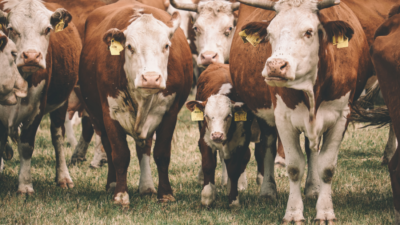
But after weaning, the calves are separated yet again at between five and nine months of age to be sent to fattening units.1Earley B. 2011. Beef cattle and veal crates. In: Webster J. ed. Management and welfare of farm animals. Chichester: Wiley-Blackwell, 120-177. Cows are strongly maternal animals and the separation of calf and mother is deeply upsetting for both the cow and her offspring.
Most calves are born either in early spring or autumn. If born in autumn, calves will spend most of their first few months of life indoors living on straw bedding, slats, cubicles or paddocks.1Earley B. 2011. Beef cattle and veal crates. In: Webster J. ed. Management and welfare of farm animals. Chichester: Wiley-Blackwell, 120-177. Poorly managed straw bedding can result in dirty, wet conditions which expose cattle to diseases. Cramming too many cattle into sheds can result in injuries, such as teat treading, where cows lose their teats.3Farm Animal Welfare Committee. 2019. Opinion on the welfare of cattle kept for beef production. Available at https://www.gov.uk/government/publications/fawc-opinion-on-the-welfare-of-cattle-kept-for-beef-production [Accessed 9 June 2020]. Housing cows indoors in inappropriate conditions increases the likelihood of pneumonia, which is the most common reason for death in young cattle from weaning to 10 months of age. 6Agricultural and Horticultural Development Board. 2018. Better management of bovine respiratory disease. Available at https://ahdb.org.uk/knowledge-library/brp-better-management-of-bovine-respiratory-disease [Accessed 15 April 2020].
In summer, we’re used to the sight of cattle in fields and tend to consider it some sort of bucolic, idyllic view of the British countryside. However, it’s easy to miss signs of suffering from afar. Cattle can be left without any shelter against the sun, such as trees or hedges, which exposes them to heat stress.5Department for Environment, Food & Rural Affairs. 2003. Code of recommendations for the welfare of livestock: cattle. Available at https://assets.publishing.service.gov.uk/government/uploads/system/uploads/attachment_data/file/69368/pb7949-cattle-code-030407.pdf [Accessed 9 June 2020]. This causes cattle – especially dark coated suckler cows or ‘high-yielding’ cows – severe problems such as abnormal breathing, severe weight loss and anoestrus, where cows do not come into season.
Suckler cows are often out-wintered, living outdoors all year round.3Farm Animal Welfare Committee. 2019. Opinion on the welfare of cattle kept for beef production. Available at https://www.gov.uk/government/publications/fawc-opinion-on-the-welfare-of-cattle-kept-for-beef-production [Accessed 9 June 2020]. While this may sound ideal, the National Animal Disease Information Service notes that even in mild winters, significant problems can occur, let alone extreme winters.7National Animal Disease Information Service. 2012. Out-wintering of cattle. Available at https://nadis.org.uk/disease-a-z/cattle/out-wintering-of-cattle/ [Accessed 15 April 2020]. If cattle aren’t healthy and big enough going into winter and aren’t given any form of shelter, they can suffer from ice, hail, snow and freezing temperatures with no protection. While wild cattle have a wide range of territory to roam, farmed cattle may be kept in small fields that get too wet, muddy and full of manure, which cattle are forced to stand and lie down in if fields don’t have good drainage. Combined with inappropriate shelter, it’s opening the door to a plethora of diseases that beef cattle suffer.
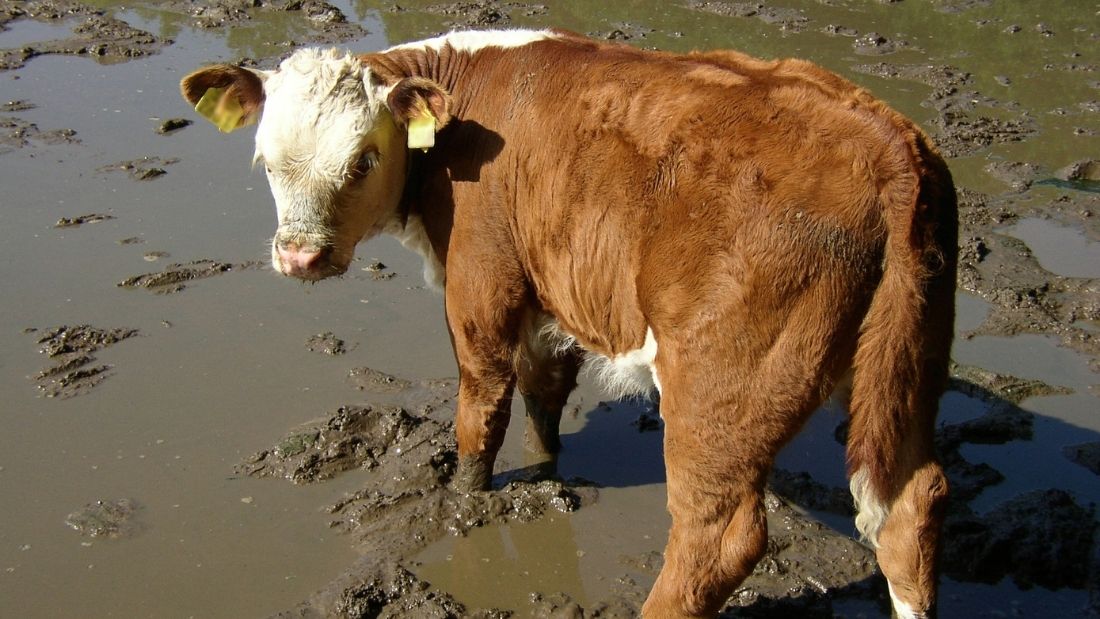
Dairy
Almost half of all beef comes from the dairy industry.1Farm Animal Welfare Committee. 2019. Opinion on the welfare of cattle kept for beef production. Available at https://www.gov.uk/government/publications/fawc-opinion-on-the-welfare-of-cattle-kept-for-beef-production [Accessed 9 June 2020].
Around 400,000 dairy-sired bull calves are born in Great Britain each year. They are seen as ‘low value’ because they are male and therefore cannot produce milk. According to figures from 2016 to 2018, around 280,000 of them enter the beef supply chain and the remaining 60,000 are slaughtered on farm.2Agricultural and Horticultural Development Board. 2020. GB Cattle Health & Welfare Group – fifth report – 2020. Available from https://ahdb.org.uk/knowledge-library/gb-cattle-health-welfare-group-fifth-report-2020 [Accessed 29 August 2023]. Thousands of those entering the beef supply chain are exported live to the continent, forced to endure long journeys on ferries.
In June 2021, the UK Government introduced the Animal Welfare (Kept Animals) Bill, which would have banned live exports of farmed animals as well as tackling puppy imports and cracking down on primates as pets. However, after months of dithering and delaying, in May 2023, the Government announced the Bill was being dropped.3UK Parliament. 2023. Animal Welfare (Kept Animals) Bill. Available from: https://bills.parliament.uk/bills/2880 [Accessed 29 August 2023].A bitter disappointment to many.

Photo Credit: Jo-Anne McArthur / Eyes On Animals
The calves destined for British slaughterhouses suffer immensely in the first days of life. At about one to two weeks of age, they suffer multiple trips to various markets until they’re sold, and they can be transported across the length of the country.4Earley B. 2011. Beef cattle and veal crates.’ In: Webster J. ed. Management and welfare of farm animals. Chichester: Wiley-Blackwell, 120-177. These poor calves don’t have access to appropriate food or water and don’t have their mothers to comfort them. They are exhausted and confused; with such stress and without the nourishment of their mothers’ milk, they are vulnerable to infection and likely to be infected, dehydrated and suffering from trauma by the time they reach the rearing unit, where mortality rates are high.4Earley B. 2011. Beef cattle and veal crates.’ In: Webster J. ed. Management and welfare of farm animals. Chichester: Wiley-Blackwell, 120-177.
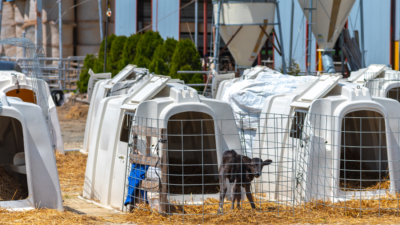
The calves are reared on a liquid milk replacement rather than their own mum’s milk and are moved onto a dry food diet to maximise profit after just five or six weeks.4Earley B. 2011. Beef cattle and veal crates. In: Webster J ed. Management and welfare of farm animals. Chichester: Wiley-Blackwell, 120-177. They should be suckling for up to a year to build up a robust immune system, learn crucial development skills and be protected, comforted and nurtured by their mothers, but instead they’re isolated from their mums, made to gain weight as quickly as possible before being slaughtered for maximum profit. The same fate awaits dairy cow mothers once their milk yield starts to decline. Because mother cows in the dairy industry suffer an exhausting cycle of lactation and pregnancy at the same time for an average of four cycles, their flesh is often low-quality once they’re slaughtered. Therefore, their flesh is used in cheap, processed products like burgers.
Buying beef funds the dairy industry; read more about what happens to calves and female cows for dairy here.
Veal

Veal is meat from calves, usually male calves from dairy herds as they cannot be used for milk production. For meat to be legally classed as veal, the calves must be less than eight months old at slaughter. White veal comes from calves fed on a liquid (usually powdered milk) diet with restricted amounts of iron. Rosé veal comes from calves that have been allowed to move around more and who have had some fibre in their diet (calf replacer pellets and forage) along with milk powder, hence the darker colour of their meat. The term ‘rosé veal’ may also be applied to meat from animals under 12 months old. Rosé veal is more popular in the UK, making up around 95 per cent of the veal market, while white veal is more popular on the continent.
Although not common in the UK, veal farms are widespread on the continent. While veal crates were banned across the EU in 2007, calves used for white veal still have very little access to exercise and are not able to move about as they should, and although a minimum requirement of iron in their diet is now in law, white veal calves are still at risk of suffering from iron deficiency anaemia leading to increased likelihood of diarrhoea, respiratory infections and difficulty dealing with physical stress.1The European Food Safety Authority. 2012. Scientific opinion on the welfare of cattle kept for beef production and the welfare in intensive calf farming systems.]The EFSA Journal. 10 (5) 2,669. Available at https://efsa.onlinelibrary.wiley.com/doi/epdf/10.2903/j.efsa.2012.2669 [Accessed 10 June 2020].
Public demand in the UK for veal plummeted when the conditions young calves were kept in were exposed. In the UK, veal production and consumption are combined with beef, so it is difficult to say exactly how much is produced and consumed, but in 2010, it made up just 0.14 per cent of UK beef consumption.2The Dairy Site. 2010. Veal production in the UK. The Dairy Site. Available at https://www.thedairysite.com/articles/2360/veal-production-in-the-uk/ [Accessed 9 June 2020].
There are attempts to popularise rosé veal – meat from ‘disposable’ male calves from the dairy industry who are killed at between eight and twelve months, most often raised in intensive units.3Earley B. 2011. Beef cattle and veal crates. In: Webster J. ed. Management and welfare of farm animals. Chichester: Wiley-Blackwell, 120-177. Calves suffer from a high rate of digestive diseases, especially bloat and abomasitis, which can cause diarrhoea and make the calf passive and weak. If left untreated, it kills the calf and so in many respects it is hardly an improvement on the white veal that people so quickly turned against.
While veal crates have been banned since January 2007, calves raised for rosé veal in the UK can still be kept in individual pens until they are eight weeks old. They can turn around and see other calves, but the calf should be with his or her mother and able to roam free, not kept in a hutch without any other animals to nuzzle and touch. After eight weeks in a solitary hutch, they are reared in groups of up to 80 calves, often in sheds with a wooden slatted floor.
About half of the veal consumed in the UK is imported from the EU, where white veal is still popular, such as in France and the Netherlands, for example, and where welfare standards are even worse. On the continent, veal calves are given just 60 per cent of the space per animal compared to the UK. Legally, veal farmers don’t need to provide bedding after the first two weeks of a calf’s life and they’re forced to stand or lie down on bare slatted floors. With their small hooves, calves struggle to walk across these slatted floors and this increases the risk of lameness and injury. They are slaughtered at between 20 and 26 weeks of age, living mostly on liquid milk replacement.1The European Food Safety Authority. 2012. Scientific opinion on the welfare of cattle kept for beef production and the welfare in intensive calf farming systems.]The EFSA Journal. 10 (5) 2,669. Available at https://efsa.onlinelibrary.wiley.com/doi/epdf/10.2903/j.efsa.2012.2669 [Accessed 10 June 2020]
Calves suffer from malnutrition and their development is severely affected by early separation from their mothers. They are typically fed twice a day when they would naturally suckle multiple times a day; this unnatural form of feeding leads to severe physiological disturbances in veal calves.1The European Food Safety Authority. 2012. Scientific opinion on the welfare of cattle kept for beef production and the welfare in intensive calf farming systems.]The EFSA Journal. 10 (5) 2,669. Available at https://efsa.onlinelibrary.wiley.com/doi/epdf/10.2903/j.efsa.2012.2669 [Accessed 10 June 2020]
While white veal is unpopular in the UK, Continental Europe still has a taste for it and the UK dairy industry exports thousands of little calves every year, an exhausting, gruelling journey, to be killed at a young age, in a confined space and with an unhealthy low-iron diet. In 2019, for example, the UK exported around 17,000 calves to Spain, the majority from Northern Ireland.4BBC. 2020. Concern over UK cattle slaughtered in Middle East. Available at https://www.bbc.co.uk/news/uk-54435029 [Accessed 29 August 2023]. While the UK might pride itself on somewhat better veal conditions than the rest of the EU, by exporting thousands of calves to the continent every year we’re just as complicit in the suffering and death of these young calves killed for veal, whether white or rosé.
Semi-intensive and intensive systems
‘Semi-intensive’ means that cattle live out on grass for one or two summers. They are either ‘finished’ indoors during their second winter, or after their second summer at just under two years of age.1Earley B. 2011. Beef cattle and veal crates. In: Webster J. ed. Management and welfare of farm animals. Chichester: Wiley-Blackwell, 120-177. ‘Intensive’ calf-rearing systems mean that calves from the dairy industry – used for rosé veal – are reared in confinement from birth to slaughter.1Earley B. 2011. Beef cattle and veal crates. In: Webster J. ed. Management and welfare of farm animals. Chichester: Wiley-Blackwell, 120-177. They don’t live out on the grass at all.
In both systems, the aim is to finish calves quickly to maximise profit, meaning that they gain weight at a higher rate than is natural and are killed as early as possible. What lives they do lead in intensive systems are as bad as it can get, with high stocking densities and an inability to express much of their natural behaviour for their whole existence.
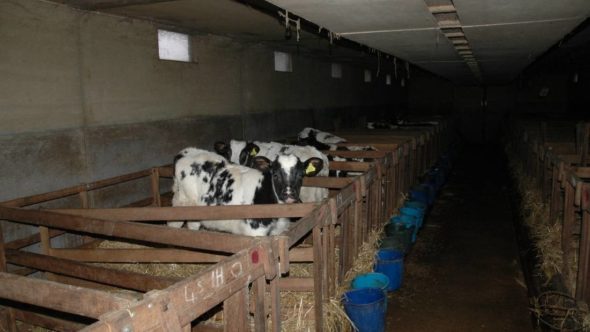
Cattle in intensive systems are fed unnatural diets of grass silage and concentrates or maize silage plus concentrates of ‘barley beef’.1Earley B. 2011. Beef cattle and veal crates. In: Webster J. ed. Management and welfare of farm animals. Chichester: Wiley-Blackwell, 120-177. In the barley beef system, cattle are fed cereal for the most part. Cattle fed barley gain weight more quickly than eating grass and so the idea is to get the cattle ready for slaughter as quickly as possible. These high-energy foods, completely unnatural to a cow’s natural diet, cause digestive disorders while the intensive system exposes cattle to infectious diseases.1Earley B. 2011. Beef cattle and veal crates. In: Webster J. ed. Management and welfare of farm animals. Chichester: Wiley-Blackwell, 120-177.
Housing systems tend to use slatted floors for manure to drop down into – making walking difficult for the cow and increasing the risk of lameness. While deep-bedded straw would be preferable, most farmers opt for concrete floors to save money.1Earley B. 2011. Beef cattle and veal crates. In: Webster J. ed. Management and welfare of farm animals. Chichester: Wiley-Blackwell, 120-177. Conditions can be cramped, leading to chronic stress in cattle, which lowers their immune system and wellbeing.1Earley B. 2011. Beef cattle and veal crates. In: Webster J. ed. Management and welfare of farm animals. Chichester: Wiley-Blackwell, 120-177. Intensive systems really are as far as you can get from how a cow should be leading his or her life.
Holstein-Friesian male dairy calves are typically kept in intensive systems.1Earley B. 2011. Beef cattle and veal crates. In: Webster J. ed. Management and welfare of farm animals. Chichester: Wiley-Blackwell, 120-177. Because they won’t yield as much profit as beef breeds, the aim is to fatten them up as quickly as possible, meaning that they put on weight at unnaturally fast rates and have even shorter lives than beef cattle before being slaughtered.
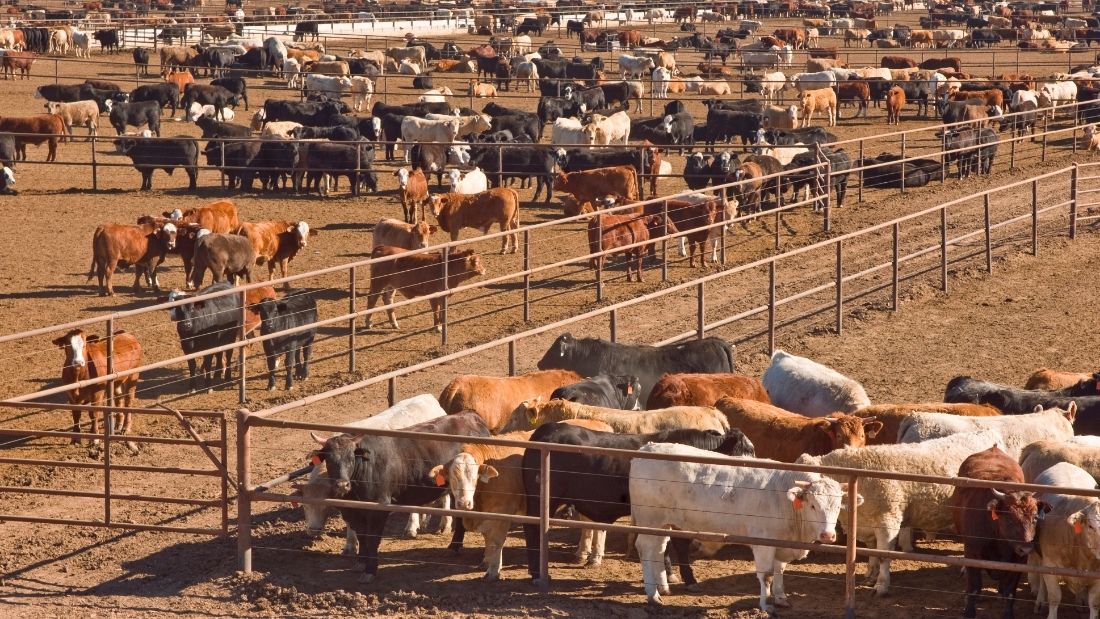
Zero grazing
In the US, mega-farms are defined as those that hold more than 125,000 birds reared for meat, or 82,000 egg-laying hens, 2,500 pigs, 700 dairy cows or 1,000 beef cattle. These are labelled by US officials as a concentrated animal feeding operation (CAFO). The US is infamous for its zero grazing feedlots or CAFOs, where huge numbers of cattle are confined outdoors in pens, the ground is trampled and they never see a blade of grass. Zero grazing units are now becoming increasingly common in the UK and in 2018, there were nearly a dozen industrial-scale fattening units, holding herds of up to 6,000 cattle at any one time.1Wasley A and Kroeker H. 2018. Revealed: industrial-scale beef farming comes to the UK. The Guardian. 29 May. Available at https://www.theguardian.com/environment/2018/may/29/revealed-industrial-scale-beef-farming-comes-to-the-uk [Accessed 15 April 2020].
Industrial beef units don’t require a government permit and the Department for Environment, Food & Rural Affairs (Defra) doesn’t have any official documentation of how many intensive beef units exist in the UK. However, research suggests that by 2021, the number of farms in the UK that met the US definition of a CAFO, or mega-farm, was 1,099.2Colley C and Wasley A. 2022. UK has more than 1,000 livestock mega-farms, investigation reveals. The Guardian. 18 August. Available at https://www.theguardian.com/environment/2022/aug/18/uk-has-more-than-1000-livestock-mega-farms-investigation-reveals [Accessed 30 August 2023].
Zero grazing is obviously a highly unnatural way of life for cattle, in direct contradiction to the Animal Welfare Act 2006, which states farmed animals must have a ‘suitable environment’ and ‘exhibit normal behaviour patterns’.3Animal Welfare Act 2006. Available at https://www.legislation.gov.uk/ukpga/2006/45/section/1 [Accessed 30 April 2020]. Despite this, feedlots may well become the standard form of farming in the UK.
Zero grazing has come about because of the UK National Beef Association wanting ‘efficiency’ – or rather, increased profits. While they claim that welfare is somehow improved, the opposite is true. The European Food Safety Authority (EFSA) notes that in a survey of 86 dairy farms in the Netherlands, “all types of hoof disorders were more prevalent in cows in zero grazing systems than among cows with some access to pasture”. The difference, they say, was substantial and their report lists a host of other health and welfare problems associated with zero grazing.4The European Food Safety Authority. 2009. ‘Scientific report on the effects of farming systems on dairy cow welfare and disease. The EFSA Journal. 1143, 1-38. Available at https://efsa.onlinelibrary.wiley.com/doi/epdf/10.2903/j.efsa.2009.1143r [Accessed 10 June 2020]. A review of five large western feedlots showed that 13 per cent of almost two million animals were treated for health problems, with lameness making up 16 per cent of them and five per cent of deaths in feedlots.5The Beef Site. 2011. Lameness in beef cattle. The Beef Site. Available at http://www.thebeefsite.com/articles/2869/lameness-in-beef-cattle/ [Accessed 9 June 2020].
Somehow farmers continue to insist that keeping cows away from pasture is beneficial for cows, despite all the evidence against such a claim. Zero grazing systems are in no way a scheme for looking after cattle’s health – quite the opposite.
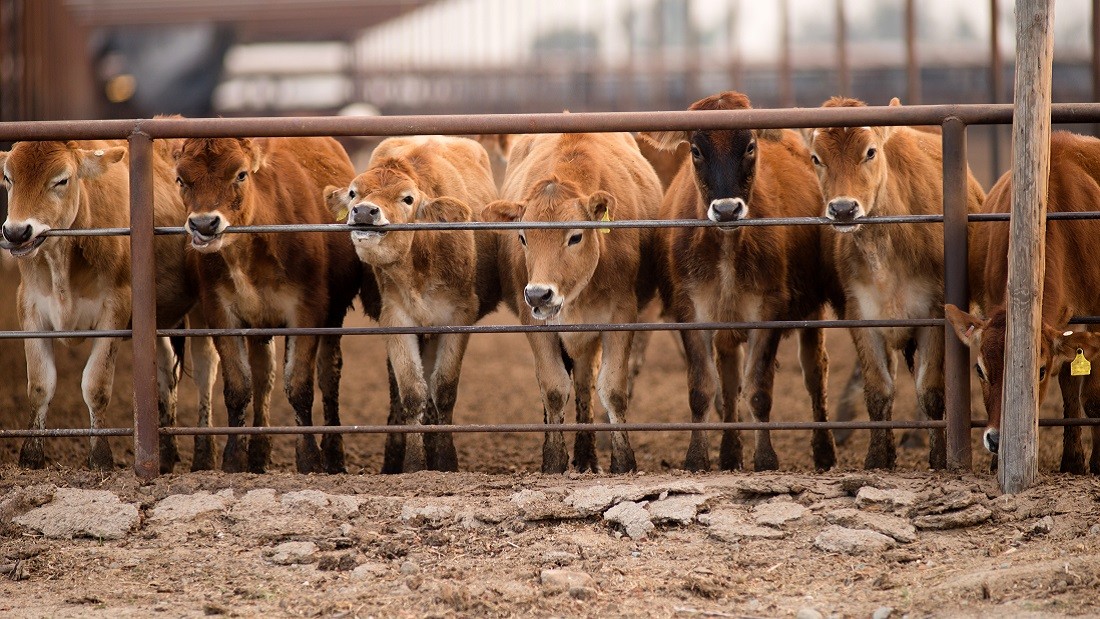
Breeding
Cattle farmers impregnate cows either by using a bull in the age-old way or with artificial insemination. The increasing popularity of artificial insemination reduces costs but however you look at it, it’s a highly unnatural, painful way of impregnating an animal.
The process requires cows to be forced into a confined space while the farmer impregnates them. One arm is inserted into the cow’s anus to manipulate her reproductive organs, while an artificial insemination gun is inserted into her vagina to deposit sperm. The procedure can cause distress, severe pain and nerve damage, especially if the cow’s organs are mishandled. Inexperienced farmers practise impregnating cows using live animals, which inevitably leads to injuries.
When cows give birth, dystocia (calving difficulty) poses a serious risk to both the mother and her calf in the short and long term and affects six per cent of calvings.1Farm Animal Welfare Committee. 2019. Opinion on the welfare of cattle kept for beef production. Available at https://www.gov.uk/government/publications/fawc-opinion-on-the-welfare-of-cattle-kept-for-beef-production [Accessed 9 June 2020]. Cows suffering from the affliction are more susceptible to metabolic and infectious disease, and calves born from difficult births are also more prone to disease and death.
Perhaps one of the most horrific cases of selective breeding in cattle is the Belgian Blue, an example of the atrocities we inflict on animals through artificial breeding.2McCahill, E. 2018. “Mutant” Belgian Blue bull stuns with shockingly muscle-bound body. The Mirror. 1 December. Available at https://www.mirror.co.uk/news/world-news/picture-mutant-belgian-blue-bull-13673907 [Accessed 9 June 2020]. Given their unnaturally high muscle to bone ratio, they suffer poor skeletal development and almost always require a caesarean section along with some other breeds.3Earley B. 2011. Beef cattle and veal crates. In: Webster J. ed. Management and welfare of farm animals. Chichester: Wiley-Blackwell, 120-177. In fact, elective caesarean sections in purebred double-muscled breeds such as the Belgian Blue are required in more than 90 per cent of births due to hypermuscularity of the foetuses. In Belgium, where the Belgian Blue is the dominant beef cattle breed, elective caesareans are carried out routinely to prevent dystocia.4Tuska HSA, Residiwati G, Verdru K et al. 2021. The impact of elective caesarean section on colostrum characteristics in double-muscled Belgian Blue cows. Theriogenology. 167, 120-125. Available at https://pubmed.ncbi.nlm.nih.gov/33813052/ [Accessed 30 August 2023].

A Belgian Blue bull, one of the most horrific examples of artificial breeding.
If cows don’t get pregnant according to the farmer’s timetable, they are killed and a target of culling five per cent of a herd each season is seen as good.3Earley B. 2011. Beef cattle and veal crates. In: Webster J. ed. Management and Welfare of Farm Animals. Chichester: Wiley-Blackwell, 120-177.
Calf Welfare
Disbudding
Calves aren’t born with horns, just little buds that later develop into the real thing. Farmers are recommended to ‘disbud’ calves at as early an age as possible so that their horns are prevented from growing. Calves are disbudded so that as older cattle they are easier to manage, such as when transporting them to slaughterhouses or separating them from mothers. It is a painful and traumatic introduction to life on the farm.
This mutilation is done either by using caustic soda, a burning chemical, a hot iron or special scoop dehorners.1National Animal Disease Information Service. 2010. Disbudding calves. Available at https://nadis.org.uk/disease-a-z/cattle/disbudding-calves/ [Accessed 1 April 2020]. It is a frightening experience for calves, who are restrained while anaesthetic is injected into both sides of their heads.1National Animal Disease Information Service. 2010. Disbudding calves. Available at https://nadis.org.uk/disease-a-z/cattle/disbudding-calves/ [Accessed 1 April 2020]. It can take a few minutes to work, meaning that the mutilation might be performed before the painkiller has taken effect, with painful results, or that the calf needs to be restrained a second time after waiting, adding to the stress.
Even with anaesthetic, there are still ways in which the calf can suffer – from brain damage, infection, fly infestations on the wounds and post-operative chronic pain.1National Animal Disease Information Service. 2010. Disbudding calves.. Available at https://nadis.org.uk/disease-a-z/cattle/disbudding-calves/ [Accessed 1 April 2020].2Mainau E, Temple D and Manteca X. 2012. Impact of dehorning and disbudding on the wellbeing of calves. Farm Animal Welfare Education Centre. August. Available at https://www.fawec.org/media/com_lazypdf/pdf/Fact_sheet_FAWEC_2_en.pdf [Accessed 1 April 2020].
Castration
Bull calves are castrated to become steers or bullocks, who are more placid, unlikely to fight each other, and put on weight more rapidly. One method is to fit tight rubber rings above the testes to crush the spermatic cord, which leads to the testes simply withering and shrinking.3Earley B. 2011. Beef cattle and veal crates. In: Webster J. ed. Management and welfare of farm animals. Chichester: Wiley-Blackwell, 120-177. Another way is surgical castration, which involves slitting open the scrotum and removing the testes.4National Animal Disease Information Service. 2010. Castration: getting the best results for farm and calf. Available at https://nadis.org.uk/disease-a-z/cattle/castration-of-calves/ [Accessed 1 April 2020]. Anaesthetic isn’t required legally unless the calf is over two months old and as the majority are castrated within the two month period, they go through the procedure with no anaesthesia and experience chronic pain.4National Animal Disease Information Service. Castration: getting the best results for farm and calf. Available at https://nadis.org.uk/disease-a-z/cattle/castration-of-calves/ [Accessed 1 April 2020]. The mutilation also increases the risk of infections and haemorrhage.4National Animal Disease Information Service. Castration: getting the best results for farm and calf. Available at https://nadis.org.uk/disease-a-z/cattle/castration-of-calves/ [Accessed 1 April 2020].
Calves are also castrated using a method called Burdizzo castration whereby a clamp crushes the spermatic cord twice for ten seconds each time, breaking the blood vessels that lead to the testicles, which are then left to waste away.3Earley B. 2011. Beef cattle and veal crates. In: Webster J. ed. Management and welfare of farm animals. Chichester: Wiley-Blackwell, 120-177.
Another reason for castration is that steer or bullock meat tends to be pinker in colour than meat from intact bull and therefore more saleable. The Government’s Animal Welfare Committee (AWC), formerly known as the Farm Animal Welfare Committee (FAWC), says that calf castration is an undesirable mutilation that should be avoided if at all possible. Despite this stark advice, it remains a routine procedure in the beef industry.4National Animal Disease Information Service. 2010. Castration: getting the best results for farm and calf. Available at https://nadis.org.uk/disease-a-z/cattle/castration-of-calves/ [Accessed 1 April 2020].
Disease and illness
The beef industry has not been integrated well, so animals are often traded and moved between different farms several times within their life. This creates a hotbed for disease; calves are more stressed because of handling, transportation and frequent exposure to new environments and other animals.1Farm Animal Welfare Committee. 2019. Opinion on the welfare of cattle kept for beef production. Available at https://www.gov.uk/government/publications/fawc-opinion-on-the-welfare-of-cattle-kept-for-beef-production [Accessed 9 June 2020]. These stressed animals have lower immune systems and mixing animals increases the risk of disease spreading between animals and across the country.
Calf mortality is ‘excessive’ – and that’s according to the industry’s National Animal Disease Information Service who says that poor hygiene practices are partly responsible.2National Animal Disease Information Service. 2010. Calf nutrition and colostrum management. Available at https://nadis.org.uk/disease-a-z/cattle/calf-management/calf-nutrition-and-colostrum-management/ [Accessed 1 April 2020]. It’s estimated that one in 13 beef calves die during the rearing phase each year; scouring causes half of all calf deaths, a painful diarrhoea-type disease that can cause dehydration, weight loss and ultimately death.2National Animal Disease Information Service. 2010. Calf nutrition and colostrum management. Available at https://nadis.org.uk/disease-a-z/cattle/calf-management/calf-nutrition-and-colostrum-management/ [Accessed 1 April 2020].
Early weaning is all part of the drive to increase growth and therefore profitability.3Agricultural and Horticultural Development Board. 2023. Key performance indicators (KPIs) for beef sector. Available at http://beefandlamb.ahdb.org.uk/wp-content/uploads/2015/01/Technical-weaning-methods.pdf [Accessed 30 August 2023]. Forced weaning is ‘a stressful time for suckled calves’, and stress lowers their immune systems, exposing them to a host of diseases.2National Animal Disease Information Service. 2010. Calf nutrition and colostrum management. Available at https://nadis.org.uk/disease-a-z/cattle/calf-management/calf-nutrition-and-colostrum-management/ [Accessed 1 April 2020]. Despite this, farmers continue to rear calves in highly unnatural ways, which expose them to painful, fatal diseases.
Neonatal deaths – those which take place between 24 hours and 28 days after birth – are so extensive that they represent “a major cause of economic concern for beef producers”.4Earley B. 2011. Beef cattle and veal crates. In: Webster J. ed. Management and welfare of farm animals. Chichester: Wiley-Blackwell, 120-177. There are many different causes of neonatal mortality including E. coli, rotavirus, Neospora, bovine coronavirus (not the human-infecting one that caused Covid-19), Cryptosporidium or Salmonella species. Calves can be as young as two days old when they are infected by Salmonella, which causes fever, a loss of appetite, blood-stained diarrhoea and – it goes without saying – immense suffering.4Earley B. 2011. Beef cattle and veal crates. In: Webster J. ed. Management and welfare of farm animals. Chichester: Wiley-Blackwell, 120-177.
Bovine respiratory disease (BRD) can leave calves with permanent lung damage and can kill; it is the most significant disease affecting calves both for their welfare and the profits of farmers in dairy and beef industries. The National Animal Disease Information Service say it is the most common reason for poor performance and death in growing calves.5National Animal Disease Information Service. 2009. Respiratory disease in dairy and beef rearer units. Available at https://www.nadis.org.uk/disease-a-z/cattle/calf-management/respiratory-disease-in-dairy-and-beef-rearer-units/ [Accessed 30 August 2023]. Causes include poor environments and management, such as draughts, poor ventilation and poor air hygiene as well as the stresses inflicted on calves through weaning, castration and disbudding.4Earley B. 2011. Beef cattle and veal crates. In: Webster J. ed. Management and welfare of farm animals. Chichester: Wiley-Blackwell, 120-177.
Bovine tuberculosis (bTB) is a common disease among cattle and for many years now, farmers have typically used badgers as a scapegoat.6Doward J. 2020. More than 100,000 badgers slaughtered in discredited cull policy. The Guardian. 28 March. Available at https://www.theguardian.com/environment/2020/mar/28/more-than-100000-badgers-slaughtered-in-discredited-cull-policy [Accessed 1 April 2020]. The Government has responded to their demands and ordered a cull of badgers in particular areas but without sound science to support the decision, despite badgers being a protected species. Over 210,000 badgers have been killed since the current badger cull began in England in 2013, but this massacre has done little to control the spread of bTB.7The Badger Trust. 2023. The badger cull. Available at https://www.badgertrust.org.uk/cull [Accessed 30 August 2023]. So lacking in scientific rigour is this cull that the Government doesn’t even test the badgers it kills to see if they have the disease or not. How can any conclusion be drawn from such a poor policy?
In cattle, bTB can cause recurring fever, weight loss and weakness. It is a zoonotic disease, meaning that it can also be passed on to humans.8National Animal Disease Information Service. 2019. Bovine TB. Available at https://nadis.org.uk/disease-a-z/cattle/bovine-tb/ [Accessed 1 April 2020]. Each year, over 40,000 cattle are compulsorily slaughtered in the UK as part of an effort to control bTB, costing UK taxpayers around £150 million per year.9 Animal & Plant Health Agency. 2023. Latest national statistics on tuberculosis (TB) in cattle in Great Britain – quarterly. Available at https://www.gov.uk/government/statistics/incidence-of-tuberculosis-tb-in-cattle-in-great-britain [Accessed 30 August 2023]. There is little doubt that the spread of bTB is due mainly to large-scale cattle movements around the UK and minimal biosecurity, which Viva! has exposed at some cattle markets. The situation is greatly exacerbated by poor and often inaccurate testing. The best cure of all would be to end cattle farming.
Read more about badgers and bTB here.
Cattle suffer from recumbency, known familiarly as ‘downer cows’ – because they are unable to stand.9National Animal Disease Information Service. 2000. Downer cow. Available at https://nadis.org.uk/disease-a-z/cattle/downer-cow/ [Accessed 1 April 2020]. If it’s too costly to treat the cow or she looks unlikely to recover, she is killed.10Department for Environment, Food & Rural Affairs. 2003. Code of recommendations for the welfare of livestock: cattle. Available at https://assets.publishing.service.gov.uk/government/uploads/system/uploads/attachment_data/file/69368/pb7949-cattle-code-030407.pdf [Accessed 9 June 2020]. Common causes are trauma from calving, resulting in nerve paralysis or bone fractures; grass staggers (magnesium deficiency or hypomagnesaemia); and infections such as mastitis, often due to poor management. Acute hypomagnesaemia is the biggest killer of suckler cows each year.4Earley B. 2011. Beef cattle and veal crates. In: Webster J. ed. Management and welfare of farm animals. Chichester: Wiley-Blackwell, 120-177.
There are a host of other diseases, including pneumonia – the leading killer of calves, foot and mouth disease, and lameness.11National Animal Disease Information Service. 2023. Disease A-Z for cattle. Available at https://nadis.org.uk/disease-a-z/cattle/ [Accessed 30 August 2023]. While lameness is known to be a serious problem in the dairy industry, it is often overlooked in beef cattle but it’s still rife. Lameness is so widespread in the beef industry that they accounted for 70 per cent of all sales for ‘non-performing’ cattle.12The Beef Site. 2011. Lameness in beef cattle. Available at http://www.thebeefsite.com/articles/2869/lameness-in-beef-cattle/ [Accessed 9 June 2020]. Cattle afflicted by lameness struggle to put on weight and are far more sickly – so much so that when lame cattle are sold or slaughtered they only fetch 53 per cent of the original purchase price.12The Beef Site. 2011. Lameness in beef cattle. Available at http://www.thebeefsite.com/articles/2869/lameness-in-beef-cattle/ [Accessed 9 June 2020].
Beef cattle are often kept on less accessible land, meaning that it can take longer for cattle to receive any treatment at all for lameness – and that’s if the farmer decides to do anything about it in the first place. In the words of the Farm Animal Welfare Committee, cattle “left untreated for protracted periods is an important issue” with cattle suffering for days before receiving treatment – and that treatment might just be slaughter.1Farm Animal Welfare Committee. 2019. Opinion on the welfare of cattle kept for beef production. Available at https://www.gov.uk/government/publications/fawc-opinion-on-the-welfare-of-cattle-kept-for-beef-production [Accessed 9 June 2020].
As if all that wasn’t enough, there are bites from ticks and midges which can go unnoticed and cause even further acute suffering.11National Animal Disease Information Service. 2023. Disease A-Z for cattle. Available at https://nadis.org.uk/disease-a-z/cattle/ [Accessed 30 August 2023].
The age at which cattle are slaughtered for beef varies by months depending on the breed and farmer but very few cattle live for more than two years.1Agricultural and Horticultural Development Board. 2022. Age at slaughter trends in GB cattle. Available at https://ahdb.org.uk/news/age-at-slaughter-trends-in-gb-cattle [Accessed 31 August 2023] Their natural lifespan, as we know, is 20 years or more so effectively, they are killed at the human equivalent of four to eight years.
Cattle are most often stunned mechanically with the use of a penetrative captive bolt shot into their heads, its percussive impact supposedly causing instant unconsciousness. There is some commercial use of electrical stunning in the UK as well.2Earley B. 2011. Beef cattle and veal crates. In: Webster J. ed. Management and welfare of farm animals. Chichester: Wiley-Blackwell, 120-177. The cow is then shackled by a hind leg and hauled up, suspended from an overhead conveyor. The slaughter worker ‘sticks’ the animal – cuts open his or her neck with a knife – and then he or she is bled to death.3Department for Environment, Food & Rural Affairs. 2015. Red meat slaughterhouses: restraining, stunning, killing animals. Available at https://www.gov.uk/guidance/red-meat-slaughterhouses-restraining-stunning-killing-animals#animal-stunning-and-killing [Accessed 9 April 2020].
It’s argued that death is painless because the cow is stunned but the moments leading up to stunning and slaughter are often terrifying for the animal. They can hear the anxious bellows and smell the fear of other cows in the slaughterhouse and often do their utmost to escape. The whole process, from transport to stunning to slaughter, is a barbaric and traumatic experience.
Stunning does not always work. The operative can miss the mark as the cow moves and the skull may be hard to penetrate, meaning several attempts may be made – the pain of which is almost unimaginable. There is also a possibility that the cow will regain consciousness, suspended from the overhead conveyor by one leg, while their throat is cut. It really doesn’t bear thinking about.
Current UK law requires animals to be stunned before they are slaughtered so they don’t feel pain. However, exemptions are allowed that permit non-stun slaughter for religious purposes.4RSPCA. 2023. Slaughter without pre-stunning. Available from https://www.rspca.org.uk/getinvolved/campaign/slaughter[Accessed 31 August 2023].In 2022, the Food Standards Agency (FSA) published a report revealing that 22 per cent of sheep, 25 per cent of goats, 2.3 per cent of poultry and one per cent of cattle did not receive a pre-slaughter stun.5Department for Environment, Food & Rural Affairs. 2022. Results of the 2022 FSA Slaughter Sector Survey in England and Wales. Available from https://assets.publishing.service.gov.uk/government/uploads/system/uploads/attachment_data/file/1096782/Results-of-the-2022-FSA-Slaughter-Sector-Survey-in-England-and-Wales.pdf[Accessed 31 August 2023].
When you consider that over one billion land animals are killed for food every year in the UK, that amounts to a huge number of animals being slaughtered without pre-stunning. It is estimated that in 2022, over 24 million sheep, cattle and poultry were slaughtered without being pre-stunned.4RSPCA. 2023. Slaughter without pre-stunning. Available at https://www.rspca.org.uk/getinvolved/campaign/slaughter [Accessed 31 August 2023]. Many British consumers unknowingly eat animal products which have come from non-stunned animals because their meat is often sold on the open market without labelling.6Dalton J. 2019. Shoppers unknowingly buying no-stun religious meat in supermarkets. The Independent 19 February. Available at https://www.independent.co.uk/news/uk/home-news/meat-animals-no-stun-halal-meat-supermarkets-religion-kosher-food-ban-standards-agency-a8786541.html [Accessed 25 March 2020].




